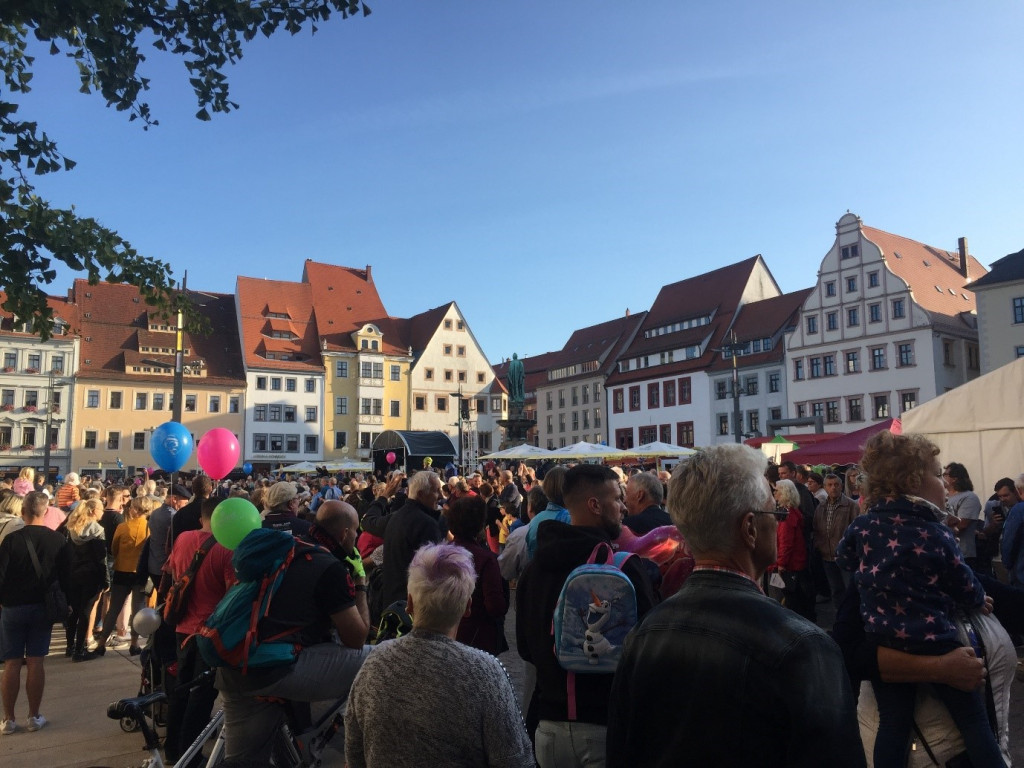
Two weeks ago Taylor and I attended the last ever short course hosted at the Centre of Volcanic Textures, (CVT, or Christoph’s Volcanic Temple), at the Technical University Bergakademie Freiberg (TUBAF) in Freiberg, Germany. The CVT course location could not have been more perfect as Freiberg is a quaint old town in eastern Germany (Saxony) with a mining history dating back to the 12th century for silver.
We were lucky to have arrived the weekend before as Freiberg was hosting the celebration for the Erzgebirge Region becoming a UNESCO World Heritage Site, honouring and preserving precious remnants of mining history. The celebration included a mining themed parade (German: Bergparade) and wrapped up with the town singing the multi-versed “Steigerlied”, named after the German word for mining foreman. The “Steigerlied” or “Steiger” is an old German song expressing the miners hope to safely reach the surface and their families after a hard day of work in the mines. .

The old castle in Freiberg currently houses terra mineralia, an incredible mineral museum whose exhibition was largely collected privately by Dr. Erika Pohl-Ströher. Her collection reached over 90 000 pieces, 3500 of which are displayed. We got a private tour round the collection by other VIPS Team Member Tobias, who happened to work there for a few years while he was studying in his hometown. The collection was mind-blowingly impressive and we highly recommend it to anyone coming to visit. Touring the town and listening to its history, it is no surprise that Freiberg is home to the TUBAF and explains how Tobias knows so much about minerals and mining.
The course itself lasted 5 days, with 4 days in the classroom and 1 day out in the field. Throughout his career Christoph has collected prime samples from around the world, and over 3000 of them are stored in the centre he has built, with an amazing amount of cut and polished pieces on display and organized in cabinets accessible to students. The course was designed for grad students who want to learn more about volcanic textures, and required little previous knowledge of volcanic systems. Many of the other students came from different geological disciplines but had stumbled upon some volcanic rocks in their research and needed to know more about them. One other participant brought 15 kg of Archean rocks from South Africa with him for help with identification!
The first day was lecture based, learning the basics of volcanic processes, i.e. different types of volcanoes and the various deposits produced by them. The days following were split into lectures and microscope sessions, where we pored over the magnificent hand samples and thin sections: —lava, ignimbrites, fallout, phreatomagmatic and submarine deposits all included. Christoph provided us each with a manual with the lecture slides (all figures referenced) that we could annotate, a short summary of volcanic processes, and a collection of JPEG’s with volcanic texture examples. We spent Thursday touring around the local area, with Christoph convincing us that even though they are old, and take a little while to find, Saxony has plenty of volcanic outcrops that we can learn from. Friday was spent finishing up with the assigned thin sections as well as valuable one-on-one time with Christoph consulting our own samples he encouraged us to bring. Christoph’s infectious enthusiasm and love for teaching and questions made the week hugely enjoyable.

variably vesicular obsidian 
phreatic eruption in a obsidian flow 
side of a dyke 
more pretty rocks displayed on wall 
coarsely porhyritic sample 
Christoph’s favourite upper Permian Chilean Lava 
The team checking out the columns at field site no 1
Taylor and I had a larger background in volcanology than the rest of the participants, but still really learned a lot, and enjoyed the lectures and discussions in class and the chance to pick Christoph’s brain. It was a great opportunity to revise all the concepts in volcanology and hone our texture skills. We also got a chance to interview Christoph (stay tuned)! He intends on retiring within the next few years and that is why this was the last of the summer courses being held. Upon his retirement Christoph plans on cataloguing and photographing his collection to assemble a book on volcanic textures, which I am sure will become a staple for generations to come. In the meantime, if anyone gets a change to visit Christoph’s magnificent lab, they should absolutely go for it.







Leave a Reply